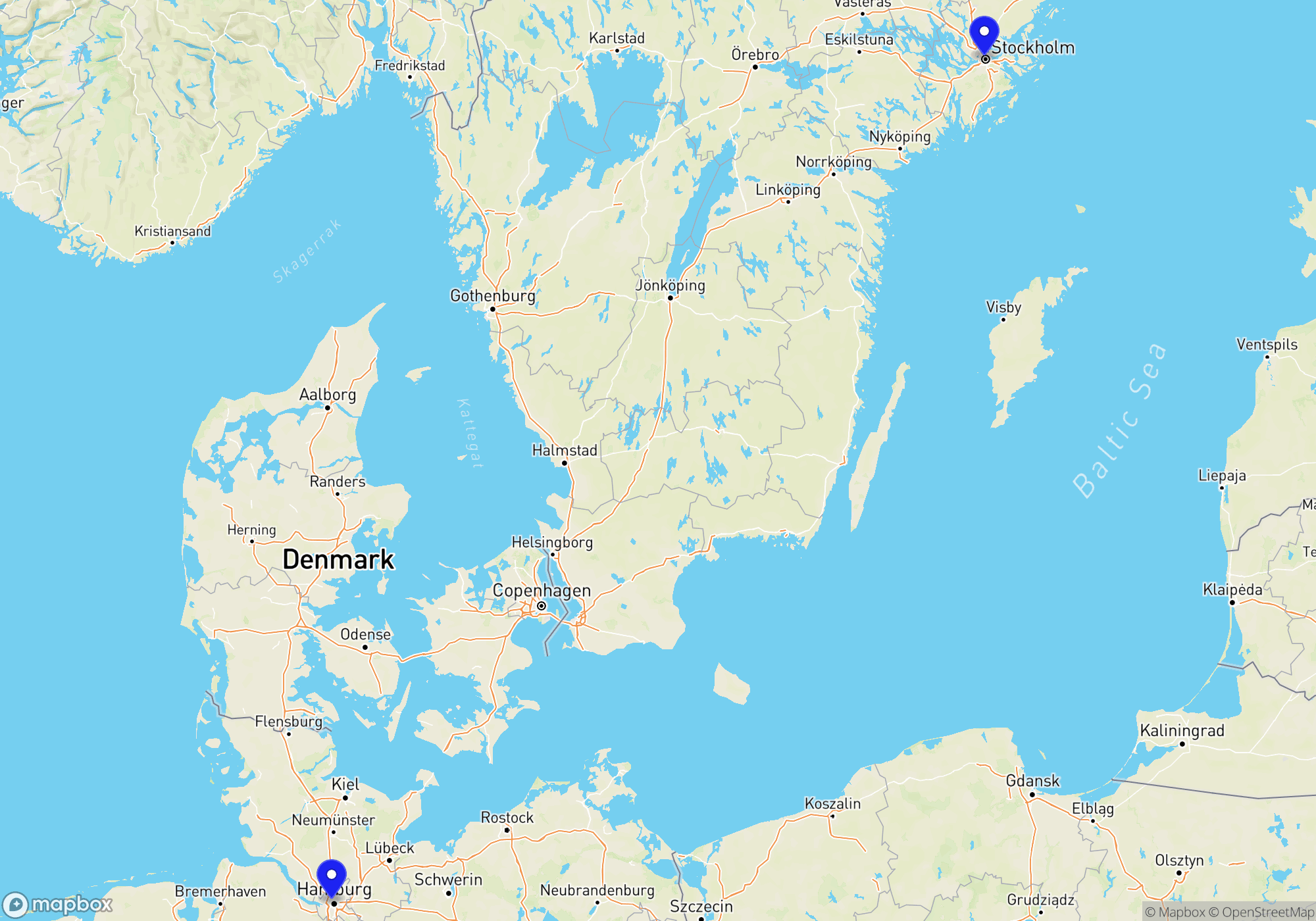
You can buy train tickets directly from the operator or through a reseller. The reseller is typically slightly more expensive (3-5%) but can provide an easier booking experience, especially if you travel with more than one operator.


These operators provide a complete journey either as a direct connection or through their partners. Even if a change of trains is involved, it’s all part of a single itinerary managed by the same train company or its partners, offering a smoother and more coordinated travel experience.
Some operators don’t run direct trains the whole way, but they serve either the departure or arrival station. In many cases, you can combine two of these operators to complete your journey by changing trains along the way. This is often a flexible and budget-friendly way to travel — especially if you’re comfortable piecing together your own itinerary.
Just keep in mind that these are separate journeys, which means a delay on the first leg could cause you to miss the second without automatic compensation or rebooking. It’s a great option for confident travelers who don’t mind a bit of extra planning.

Deutsche Bahn (DB), the German railway company, is well-known for its extensive train network throughout Germany and beyond, offering a variety of trains including high-speed ICE (InterCity Express), IC (InterCity), and regional trains. The ICE trains are particularly popular for their speed and comfort, featuring amenities such as spacious seating with power outlets, Wi-Fi, dining cars or at-seat meal services, and quiet zones for uninterrupted travel. Deutsche Bahn provides excellent customer support services through their online platforms, mobile apps, and at stations, assisting with ticket bookings, real-time updates, and passenger inquiries.
FlixTrain, a part of the FlixMobility group that also operates FlixBus, offers a more budget-friendly option for rail travel. FlixTrain focuses on providing low-cost service without sacrificing basic comfort, featuring comfortable seating and free Wi-Fi as their main amenities. Their trains may not have the extensive food services found on DB trains, but they provide a convenient and affordable travel option. FlixTrain has a user-friendly booking platform, integrated with their bus services for seamless travel planning, and offers customer support online, by phone, and through their app to assist passengers with questions or concerns.
First-time travelers should note that both operators offer advanced online ticket booking, often with significant savings if booked ahead. They also provide detailed travel information and updates via mobile apps, which are invaluable for planning and during transit, ensuring a smooth journey from Stockholm to Hamburg.
The Interrail Global Pass is valid for traveling by train from Stockholm to Hamburg as it covers multiple countries in Europe, including the route from Sweden to Germany. The Interrail One Country Pass would not be applicable for the entire journey since it only covers train travel within one single country, and this journey involves travel across both Sweden and Germany. The Eurail Pass is also valid for this journey as it is designed for non-EU residents traveling across multiple European countries, including Sweden and Germany.
Upon arriving in Hamburg by train, you’ll likely find yourself at the Hamburg Hauptbahnhof, the city’s central station. From there, Hamburg’s local transportation network is well-connected and efficient, primarily featuring the U-Bahn (metro), S-Bahn (suburban train), buses, taxis, and ridesharing options.
The U-Bahn and S-Bahn systems are the backbone of public transportation in Hamburg, offering extensive coverage across the city and into surrounding areas. The S-Bahn is particularly useful for reaching outer districts and nearby suburbs, while the U-Bahn covers central Hamburg efficiently. Tickets are integrated, allowing travel across both systems without needing multiple tickets. You can purchase tickets at machines in each station or via the HVV app. The Hamburg Card is an excellent option for tourists, offering unlimited travel on public transport along with discounts on various attractions.
Buses complement the train network, providing service to areas not directly accessible by train. Look for stops near major transit hubs for ease of transfer between bus and train. Night buses assure transportation even during late hours when regular services may be less frequent.
If you prefer more direct travel, taxis are readily available and can be hailed on the street or at designated taxi stands, particularly around major stations like the Hauptbahnhof. Taxis offer metered fares, and it is common to tip the driver.
For ridesharing, services like Uber operate in Hamburg, providing an alternative to traditional taxis. You can book a ride through the Uber app, which may offer more competitive pricing and the convenience of cashless transactions.
Overall, Hamburg’s local transportation options are comprehensive and user-friendly, making it easy to navigate the city without needing a car.
Hamburg, a major hub in Northern Germany, is well-connected by rail both domestically and internationally. Domestically, one of the most popular routes is from Hamburg to Berlin. This journey typically takes under two hours, with frequent Intercity-Express (ICE) trains operated by Deutsche Bahn providing fast and efficient service. Another significant domestic connection is between Hamburg and Munich, a route that takes around six hours on the high-speed ICE trains, offering several departures throughout the day. Hamburg is also well linked to Cologne and Frankfurt, with high-speed trains making these routes accessible within approximately four hours.
Internationally, Hamburg serves as a key gateway to Denmark, with direct trains to Copenhagen on the EuroCity (EC) services, usually taking around five hours. Trains to Aarhus also offer convenient connections through the Flensburg border crossing. For travel to the Netherlands, there are routes to Amsterdam that often involve a transfer in Osnabrück, making the total journey time around five and a half hours. Additionally, there are connections to Zurich, Switzerland, which take about nine hours, often with a change in Basel, also served by Deutsche Bahn’s ICE trains.
These rail links make Hamburg a strategic start point for travelers exploring both Germany and its neighboring countries, providing scenic and comfortable journeys through various landscapes.
The best months to visit Hamburg are generally May through September. During this period, the weather is mild and pleasant, making it ideal for exploring the city’s outdoor attractions and enjoying its vibrant atmosphere. In May and June, you can experience the bloom of spring with comfortable temperatures and longer daylight hours. July and August are the warmest months, suitable for enjoying events like the Alstervergnügen festival and the Schlagermove parade. However, these peak summer months can also see higher prices in accommodation and more crowded attractions. September offers a pleasant early autumn climate with fewer tourists and the chance to attend the Reeperbahn Festival. Additionally, this period boasts an array of outdoor activities, street festivals, and the scenic beauty of Hamburg’s parks and waterways. Arriving by train, you’ll find excellent connections to Hamburg from various European cities, enhanced during the summer when tourism is at its height. For those seeking lower costs and fewer crowds, the shoulder months of late spring and early fall are advantageous, balancing fair weather with reasonable travel expenses.
When traveling from Stockholm to Hamburg by train, it is essential to pack your valid passport or national ID card, a printed or digital train ticket, and any necessary visas depending on your nationality. Bring a universal power adapter for the different plug types in Germany, as Swedish Type C and F plugs are compatible, but verify your devices’ plug size. Pack comfortable clothing and shoes suitable for both travel and exploring Hamburg. Carry essential toiletries in travel-sized containers and bring personal medications with prescriptions. Consider headphones, a good book or e-reader, and snacks to enjoy during the journey. Pack a reusable water bottle to stay hydrated and a portable charger to keep electronics powered. Bring an umbrella or lightweight rain jacket, as Hamburg weather can be unpredictable. Make sure to have a debit or credit card with some local currency for immediate expenses upon arrival. Don’t forget sunglasses, a small backpack for daily excursions, and a travel guide or map of Hamburg.
Some content on this website is created with the assistance of generative AI. To ensure factual accuracy, all information is reviewed by an expert in European train travel. However, despite careful verification, occasional errors or updates may not be immediately reflected. © 2025 Green Company. All rights reserved.